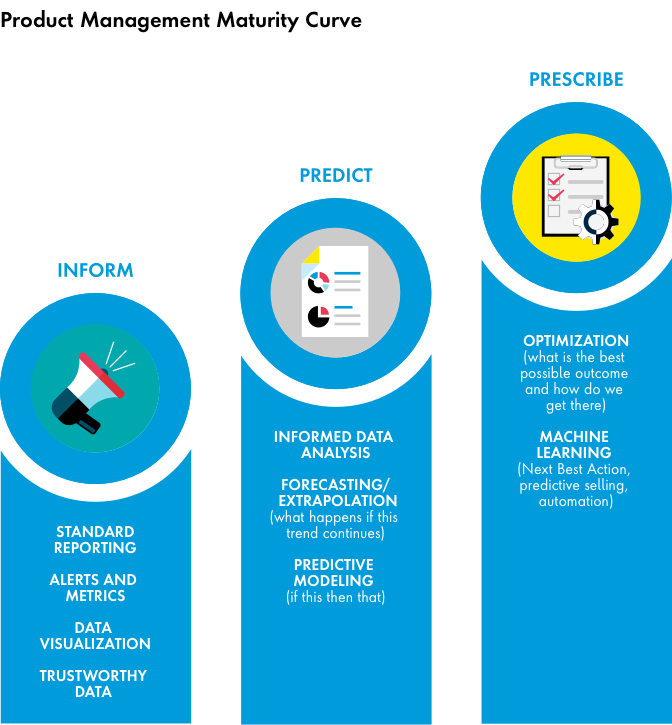What issue can we solve for you?
Type in your prompt above or try one of these suggestions
Suggested Prompt



A few years ago, I was sitting in a client’s conference room with a handful of tech and business leaders, all of whom were talking about the exciting things they saw at Dreamforce the prior week. They were also lamenting how far they were from using the “new bells and whistles.” As I sat and listened to what excited them and which features seemed most shiny, I started to think about the building blocks that would actually be required to get them to a place, technologically, where these bells and whistles could be implemented.
With the lens of “Informing, Predicting and Prescribing” in mind, I quietly began plotting out on the whiteboard various use cases that we had previously discussed or that I had heard in the minutes prior. Conversation slowed as the room noticed what I was doing. Once I had a few different rows on the board, I stopped to explain my thinking. As I walked everyone through the different use cases and the progressions that would take a process or piece of data from being informative to predictive to prescriptive, I could almost hear the wheels turning. We now had a path to each of the shiny and “unattainable” features that everyone had seen the last week, specific to them and the business they were running. The idea of evolving and innovating suddenly didn’t seem so far-fetched or daunting, but instead sparked questions such as “which one should we do first”?
Over the last decade, enterprise technology solutions have created a more complex tech landscape than ever before. Companies have more information and data readily available, paired with an endless variety of products and solutions, making personalized experiences for customers the new norm. Gone are the days of patience for a customer service representative to figure out who you are and what your inquiry could be in reference to, or waiting weeks for a package to ship from the time it is ordered, or for a web page to load or buffer. Consumers’ expectations of immediate response times, custom product recommendations, and seamless interfaces have created a world in which enterprises must keep up, or they will be left behind.
Salesforce has been recognized by industry analysts and leading user review organizations as the market leader for CRM technology. While Salesforce provides out-of-the-box solutions that allow growing businesses to easily implement cutting-edge technology, it is a platform that is ever-changing, releasing new features multiple times a year. Contrasting the way that old systems were built and managed, Salesforce is a solution that is intended to evolve, be it with changing business/market needs, or with new features and functions. It can be used as an expensive rolodex or a wall-to-wall solution for all of a company’s business processes and customer interactions. Within the past few years, we have seen a completely reinvented user interface, a focus on augmented intelligence (AI), and solutions for master data management (to name a few)—all of which are features that help enable the customized experience that consumers expect.
Today’s competitive marketplace requires a deeper level of change to keep up or stay ahead in the marketplace. Specifically, businesses must invest in product innovation, the integration of technology and frameworks, and open platforms. Plotting the path to innovation is tough. With so many options for enterprise tech solutions, it can feel overwhelming to zoom out and understand the bigger picture and the path to get there. Breaking down ideas to be digestible and actionable is a critical step to driving value and change within an organization. Once you have the building blocks identified, you can prioritize and start to create a roadmap and plan. Whether it is moving from paper to digital, implementing a complete eCommerce solution, or streamlining the customer service experience with chat bots, ongoing innovation within the platform is the way in which companies will realize ROI.
Enter the Product mindset. A Product mindset means measuring success with business metrics like user adoption and retention, and the revenue or cost savings generated per feature. It is represented by an ongoing roadmap that is comprised by value-driving initiatives and features. This leads to less waste, more creativity, and more releases. Salesforce, when viewed within an enterprise as a Product, positions companies to drive outcomes, through the platform, more quickly and efficiently. This way of working places emphasis on cost savings (via efficient work patterns) and increased ROI (through outcome-based prioritization processes).Publicis Sapient recognizes this need for ongoing innovation, support, and maintenance on the platform and that it is imperative to effectively evolve, compete, and thrive in the ecosystem. We combine strategy, Salesforce expertise, and engineering best practices, creating an environment for optimal efficiency and ground-breaking solutions. We couple Agile delivery with regular strategic planning and ongoing system maintenance, bundling a top to bottom operating model to partner with our customers. Our teams work together with clients to continuously deliver functionality, driving value to end users and customers at a quick pace. By taking these building blocks, and delivering them efficiently over the course of time, it constantly moves the business up the “Inform, Predict, Prescribe” maturity curve.

Simultaneously, the structure of the program enables stakeholders to effectively communicate change, priorities, and updates to the business, setting expectations and creating transparency more than ever before. These meaningful solutions propel businesses forward, elevating above the status-quo with streamlined processes, trustworthy data, and enhanced customer experiences. This is how customers succeed in the Salesforce space — they become the shiny thing that everyone aspires to be.
Back in the conference room with my clients a few years ago, we took these ideas and this path to maturity and created a roadmap. Some of the ideas fell off or were deprioritized, while others were delivered and drove measurable change within the business (reduced process times by 50%+, increased customer engagement and reduced duplicity between departments). Our ability to partner with them and set priorities changed the way in which the platform was viewed —as a vehicle to innovation rather than another item in the tech stack list. The roadmap constantly changes, as does the market, but the positive direction in which our client wanted to move remained constant.
Are you ready to identify how to move forward? Do you want to bring to life the innovations on stage at Dreamforce, but don’t know how to get there? Let us help!




